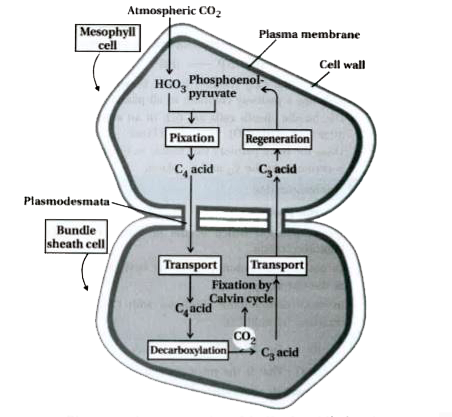Explain : Where is Hatch-Slack pathway seen ?
Text Solution
Plants that are adapted to dry tropical regions have the pathway.
These plants have the oxaloacetic acid as the first fixation product. They use the pathway or the Calvin cycle as the main biosynthetic pathway.
Internal specially of plants leaves :
(1) plants are special. They have a specia type of leaf anatomy, they tolerate higher temperatures.
They show a response to high light intensities.
They lack a process called photorespirations.
They have greater productivity of biomass.
(5) In vertical sectio of leaves, one of a plant cells of mesophyll are seen.
(6) The particularly larage cells around the vascular bundles of the pathway plants are called bundle sheath cells, and the leaves which have such anatomy are said to have .Kranz. anatomy.
(7) Here "Kranz" means "wreath" and is a reflection of the arrangement of cells.
(8) The bundle sheath may have severa layers around the vascular bundles.
(9) They are characterised by having a large number of chloroplasts, thick walls impervious to gaseous exchange and no intercellular spaces.
(10) There are no inter - cellular spaces around cells. If we cut a section of the leaves of plants - maize or sorghum - to observe the Kranz anatomy and the distribution of mesophyll cells.

The pathway shown in given figure is called Hatch and slack pathway. This is also a cyclic process.
Stages or steps of pathway : Steps of pathway are as follows :
Step 1 : Atomspheric enters into the cells of mesophyll where the primary acceptor is a 3-carbon molecule phosphenonlpyruvate (PEP)
The enzyme responsible for this fixation is PEP carboxylase or PEPcase.
The mesophyll cells lack RuBisCO enzyme.
The acid OAA in the mesophyll cells
Step 2 : It then forms other 4-carbon compounds like malic acid or aspartic acid in the mesophyll calls itself. which are transported to the bundle sheath cells. In the bundle sheath cells these acids are broken down to release and a 3-carbon molecule.

Step 3 : The 3 carbon molecul is tranported back to the mesophyll where it is converted to PEP again, thus completing the cycle
Pyuruic acid Inmesophylll (in presence of ATP)
Pyruvic acid + ATP (PEP)
Step 4 : The relased in the bundle sheath cells enteres the or the Calvin pathway, a pathway common to all plants.
The bundle sheath cells are rich in an enzyme Ribulose, biophosphate carboxylase-oxygenase (RuBisCO), but lack PEPcase.
Thus, the basic pathway that result in the formation of the sugars, the calvin pathway is common to the plants.
|
Updated on:21/07/2023
Topper's Solved these Questions
- BOOK - KUMAR PRAKASHANCHAPTER - PHOTOSYNTHESIS IN HIGHER PLANTSEXERCISE - SECTION - B (DIFFERENCE / SCIENTIFIC REASONS )(GIVE DIFFERENCE : (2 MARKS)9videos
PHOTOSYNTHESIS IN HIGHER PLANTS
- BOOK - KUMAR PRAKASHANCHAPTER - PHOTOSYNTHESIS IN HIGHER PLANTSEXERCISE - SECTION - C (DEFINITION / EXPLANATION - TERMS / LOCATION - FUNCTION / FULL NAME) (DEFINITIONS / EXPLANATION :(1 MARK)27videos
PHOTOSYNTHESIS IN HIGHER PLANTS
- BOOK - KUMAR PRAKASHANCHAPTER - NEURAL CONTROL AND COORDINATIONEXERCISE - OBJECTIVE SECTION (FILL IN THE BLANKS)12videos
NEURAL CONTROL AND COORDINATION
- BOOK - KUMAR PRAKASHANCHAPTER - PLANT GROWTH AND DEVELOPMENTEXERCISE - OBJECTIVE SECTION (FILL IN THE BLANKS)7videos
PLANT GROWTH AND DEVELOPMENT
Similar Questions
Knowledge Check
- Question 1 - Select One
In Hatch and Slack pathway
AChloroplast are of same typeBOccurs in Kranz anatomy where mesophyll have small chloroplast wheres bundle sheath have agranal chloroplastCOccurs in Kranz anatomy when mesophyll have small chloroplast where a bundle sheath have larger chloroplastDKranz anatomy where mesophyll cell are diffused
Calvin cycle operates in chloroplasts. Where does Hatch-Slack pathway occur
View SolutionCalvin cycle operates in chloroplasts. Where does Hatch-Slack pathway occur
View SolutionCalvin cycle operates in one type of chloroplasts, whereas Hatch - Slack pathway occurs in
View SolutionDiscuss the mechanism of Hatch-Slack pathway in C4 plants.
View SolutionThe first step of CO2 fixation in Hatch and Slack's pathway in plants is
View SolutionThe first step of CO2 fixation in Hatch and Slack's pathway in plants is
View SolutionSome of these terms/chemicals are associated with the C4 cycle. Explain.
(a) Hatch Slack pathway
(b) Calvin cycle
( c) PEP carboxylase ltbegt (d) Bundle shelth cellsView Solution

